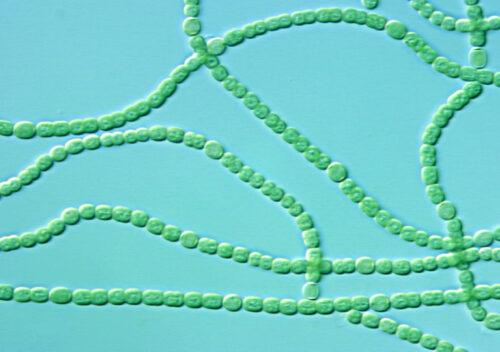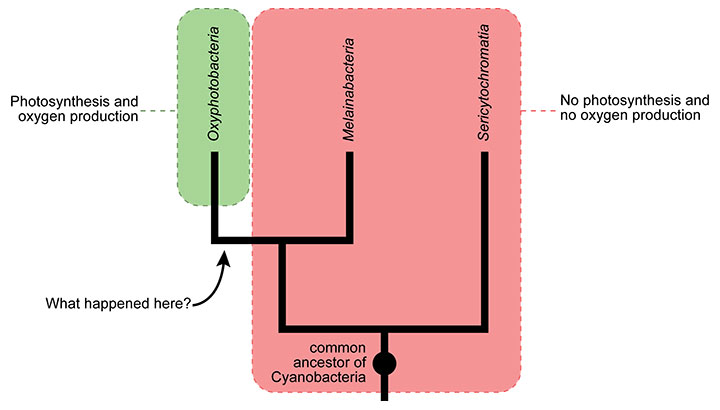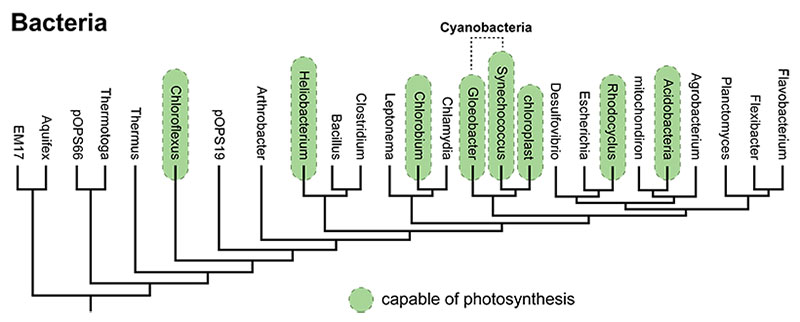
The make-up of Earth’s atmosphere, once the domain of Earth science textbooks, has become an increasingly “hot” news topic in recent decades. As the evidence pointing to human-produced greenhouse gases as the cause of ongoing and future global climate change has mounted, so too has public attention to this threat — most recently manifest in concern over whether the United States will pull out of the Paris climate accord. That accord aims to curb global warming by limiting the greenhouse gases, notably carbon dioxide, that human activity adds to the atmosphere. Atmospheric carbon dioxide levels have increased by more than 40% since the Industrial Revolution. That buildup makes a significant impact on our climate, but overall, carbon dioxide still comprises a small percentage of the atmosphere, less than 0.05%. About 21% of Earth’s atmosphere is oxygen, and most of the rest is nitrogen. But it hasn’t always been so. When life first arose (likely more than four billion years ago), there was no free oxygen in the atmosphere at all. Life was anaerobic, meaning that it did not need oxygen to live and grow. What happened to change the Earth’s atmosphere into one that could support oxygen-loving (and carbon dioxide-generating!) organisms like us? Evolution happened — specifically, the evolution of Cyanobacteria, a group of single-celled, blue-green bacteria.
Where's the evolution?
Figuring out the “whodunnit” in the oxygenation of Earth’s atmosphere 2.4 billion years ago was relatively easy. Scientists know of only one process that could produce such large amounts of oxygen: photosynthesis. At the time that the planet was oxygenated, Earth was populated exclusively by single-celled organisms (Archaea and Bacteria), and only one of these can perform the sort of photosynthesis that splits a water molecule and results in oxygen gas: Cyanobacteria, whose blue-green color comes from chlorophyll. Today, Cyanobacteria can be found almost everywhere on Earth — likely right outside your door in the soil — and still play an important role in producing the oxygen that we breathe.
While it was easy to figure out who did it with regard to our oxygenated atmosphere, figuring out how they did it has been trickier. Up until five years ago, we didn’t have anything to compare the Cyanobacteria to. Scientists knew of oxygen-producing Cyanobacteria (called the Oxyphotobacteria) and some rather distant bacterial relatives with simpler forms of photosynthesis that don’t produce oxygen — and that was it.
However, scientists recently discovered two cyanobacterial groups that reveal the evolutionary steps leading up to our breathable atmosphere. It turns out that the closest known relatives of the oxygen-producing Cyanobacteria, the Melainabacteria (discovered in 2013) and the Sericytochromatia (whose discovery was announced just last month), cannot photosynthesize at all — let alone produce oxygen. And it’s not just that they lost this ability over evolutionary time. Scientists scanned the genomes of these lineages and found no broken down bits of the genetic machinery for photosynthesis that we’d expect to see if they had lost this power. Instead, the two newly discovered groups seem never to have had it in the first place. This suggests that the most recent common ancestor of these three lineages couldn’t photosynthesize either. So how did the oxygen-producing Cyanobacteria evolve this ability?
All photosynthetic pathways, including those of the Cyanobacteria, are quite similar. This suggests that they all evolved from a common ancestral pathway — in other words, that they are homologous. However, all the different bacteria that photosynthesize are rather distantly related to one another. The genes coding for photosynthetic pathways seem homologous, but the lineages bearing them are not closely related enough for a common ancestor to have passed the pathways on to all of them. What’s the explanation for this apparent paradox? Horizontal transfer.
Humans and most multi-cellular organisms are mainly limited to transferring genetic material vertically — that is, from parent to offspring. However, among many single-celled organisms, horizontal transfer — sharing genetic material directly with another, coexisting member of your own or another species — is commonplace. The new genetic material may then be incorporated into the recipient’s genome and passed on to its offspring. This process is part of what allows microorganisms to evolve so quickly today — for example, in the rapid evolution of resistance to new antibiotics. Scientists think that horizontal transfer also occurred frequently during the early evolution of life and explains why so many distantly related bacterial lineages can photosynthesize: the genes coding for these processes were passed directly from lineage to lineage, and when the genes were successfully picked up, incorporated into a lineage’s genome, and deployed, that lineage was likely favored by natural selection. Being able to get energy from the sun probably offered a significant survival advantage!
So it seems that the basic chemical pathways for capturing energy from the sun evolved in some bacterial lineage several billion years ago (scientists still aren’t sure in which lineage) and the genes encoding these processes were picked up by one lineage of Cyanobacteria. Then, through the processes of random mutation and natural selection, that lineage eventually evolved a version of the pathway that produces oxygen. This lineage, the ancestor of modern oxygen-producing Cyanobacteria, was so successful that its waste product (oxygen) eventually transformed the atmosphere into the breathable one that we depend upon today.
Once Earth’s atmosphere was full of oxygen, the stage was set for the evolution of aerobic respiration — the process that uses oxygen to convert food into usable energy. The sets of genes responsible for this metabolic pathway were also shared horizontally among the single-celled organisms living on Earth at the time. The oxygen-producing Cyanobacteria, as well as their non-photosynthetic brethren, Melainabacteria and Sericytochromatia, picked up versions of these genes — and so did many others. Importantly (for us and other multicellular organisms), the bacterial lineage that gave rise to our own mitochondria also wound up with aerobic respiration before being engulfed by another cell and evolving into the first eukaryote, our ancestor. And, of course, ultimately, one of these early eukaryotic cells engulfed a Cyanobacterium and evolved into a chloroplast-bearing lineage, the ancestor of modern plants, which have carried on the proud tradition of photosynthesis and oxygen production started by their single-celled forebears. And the rest, as they say, is history — evolutionary history in this case. Life, of both the single- and multi-celled varieties, flourished, leading to the abundant biodiversity that we observe around us.
The atmosphere and biosphere are inextricably linked: changes in living things impact the atmosphere, and the atmosphere, in turn, affects life’s ecology and evolution. Today, of course, changes to the atmosphere (an increase in greenhouse gas levels, not oxygen) caused by a single lineage (humans, not Cyanobacteria) once again seem poised to change the Earth forever. Only this time, the effects won’t take billions of years to play out and the outlook isn’t so sunny. Understanding these connections is important because it gives us the chance to change the nature of the interaction. We know that steps like reducing our production of greenhouse gases or investing in carbon sequestration research could change things — if we can only manage to put that knowledge into action.
Primary literature:
- Blankenship, R. E. (2010). Early evolution of photosynthesis. Plant Physiology. 154: 434-438. Read it »
- Blankenship, R. E. (2017). How Cyanobacteria went green. Science. 355: 1372-1373. Read it »
- Soo, R, M., Hemp, J., Parks, D. H., Fischer, W. W., and Hugenholtz, P. (2017). On the origins of oxygenic photosynthesis and aerobic respiration in Cyanobacteria. Science. 355: 1436-1440. Read it »
News articles:
- A press release on the new research from Caltech University
- The latest update on the Paris climate accord from CNN
Understanding Evolution resources:
- An overview of bacterial evolution, with a description of horizontal transfer
- An interactive reader on homologies
Background information from Understanding Global Change:
- The article above mentions the discovery of two lineages of Cyanobacteria. What did scientists figure out about the evolution of photosynthesis in Cyanobacteria based on these two groups? Be sure to describe the evidence that led to these conclusions in your explanation.
- In your own words, explain the difference between vertical and horizontal gene transmission.
- Describe the evidence that supports the idea that photosynthesis arose once and was passed to many lineages via horizontal transfer.
- How did the evolution of oxygen-producing photosynthesis change the atmosphere? How did this atmospheric shift affect the evolution of respiration? Be sure to include the concept of natural selection in your answer.
- Do some research and describe another case in which horizontal transfer played an important role in the evolution of a lineage.
- Teach about horizontal transfer: This news brief from 2008 for grades 9-16 explains the quirks of bacterial evolution, including horizontal transfer, that make them such speedy evolvers.
- Teach about the evolution of photosynthesis and aerobic respiration: These four slide sets targeting undergraduate-level biology address connections between basic metabolic processes and evolution. Download them using the links below:
- Blankenship, R. E. (2010). Early evolution of photosynthesis. Plant Physiology. 154: 434-438.
- Blankenship, R. E. (2017). How Cyanobacteria went green. Science. 355: 1372-1373
- Brochier-Armanet, C., Talla, E., and Gribaldo, S. (2009). The multiple evolutionary histories of dioxygen reductases: implications for the origin and evolution of aerobic respiration. Molecular Biology and Evolution. 26: 285-297.
- Butler, J. H. (May 10, 2013). CO2 at NOAA's Mauna Loa Observatory reaches new milestone: tops 400 ppm. Earth System Research Laboratory, Global Monitoring Division. Retrieved April 28, 2017 from https://www.esrl.noaa.gov/gmd/news/7074.html
- Di Rienzi, S. C., Sharon, I., Wrighton, K. C., Koren, O., Hug, L. A., Thomas, B. C., ... Ley, R. E. (2013). The human gut and groundwater harbor non-photosynthetic bacteria belonging to a new candidate phylum sibling to Cyanobacteria. eLife. 2: e01102.
- Dodd, M. S., Papineau, D., Grenne, T., Slack, J. F., Rittner, M., Pirajno, F., ... Little, C. T. S. (2017). Evidence for early life in Earth's oldest hydrothermal vent precipitates. Nature. 543: 60-64.
- Hohmann-Marriott, M. F., and Blankenship, R. E. (2011). Evolution of photosynthesis. Annual Review of Plant Biology. 62: 515-548.
- Soo, R, M., Hemp, J., Parks, D. H., Fischer, W. W., and Hugenholtz, P. (2017). On the origins of oxygenic photosynthesis and aerobic respiration in Cyanobacteria. Science. 355: 1436-1440.


